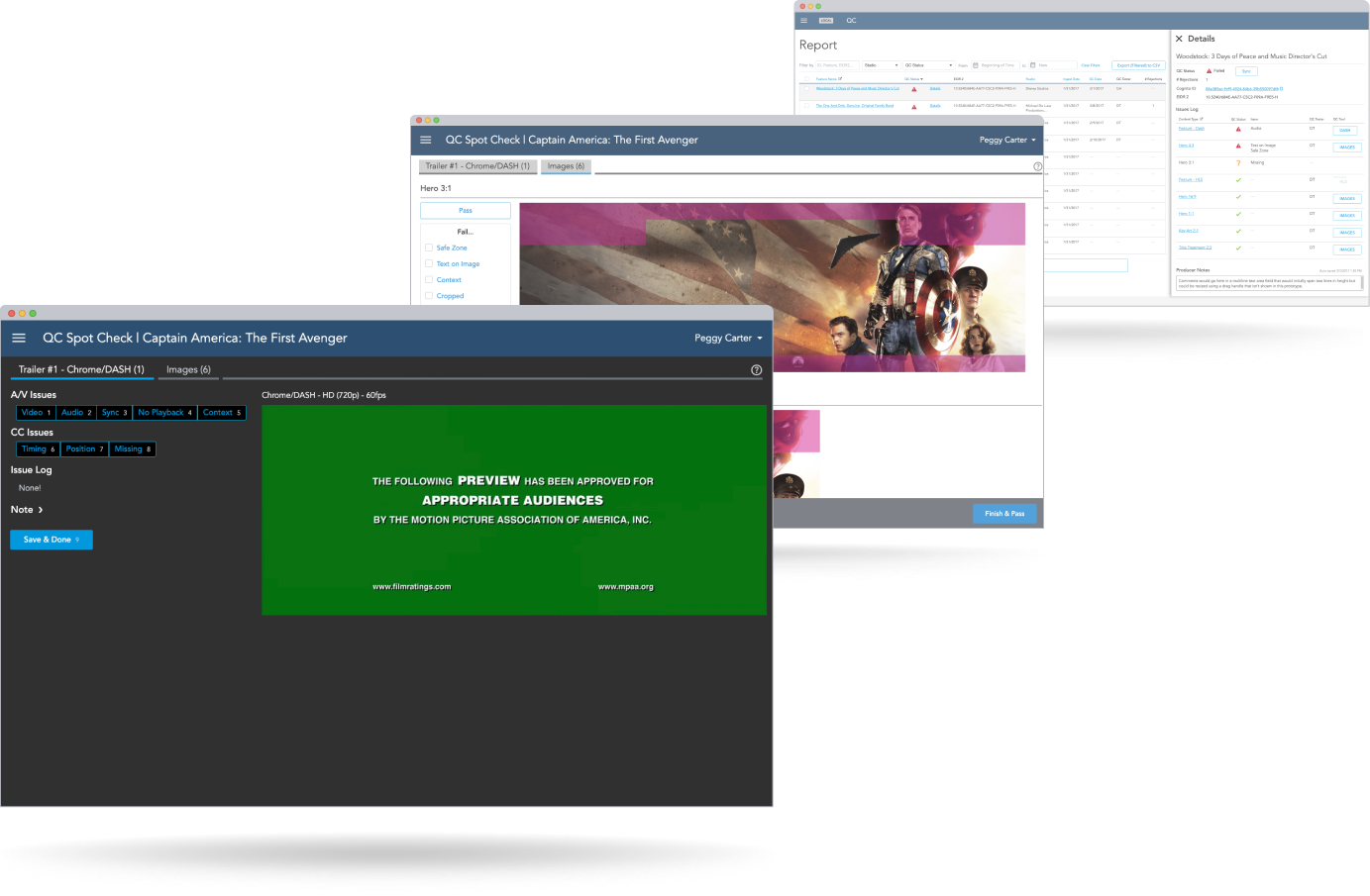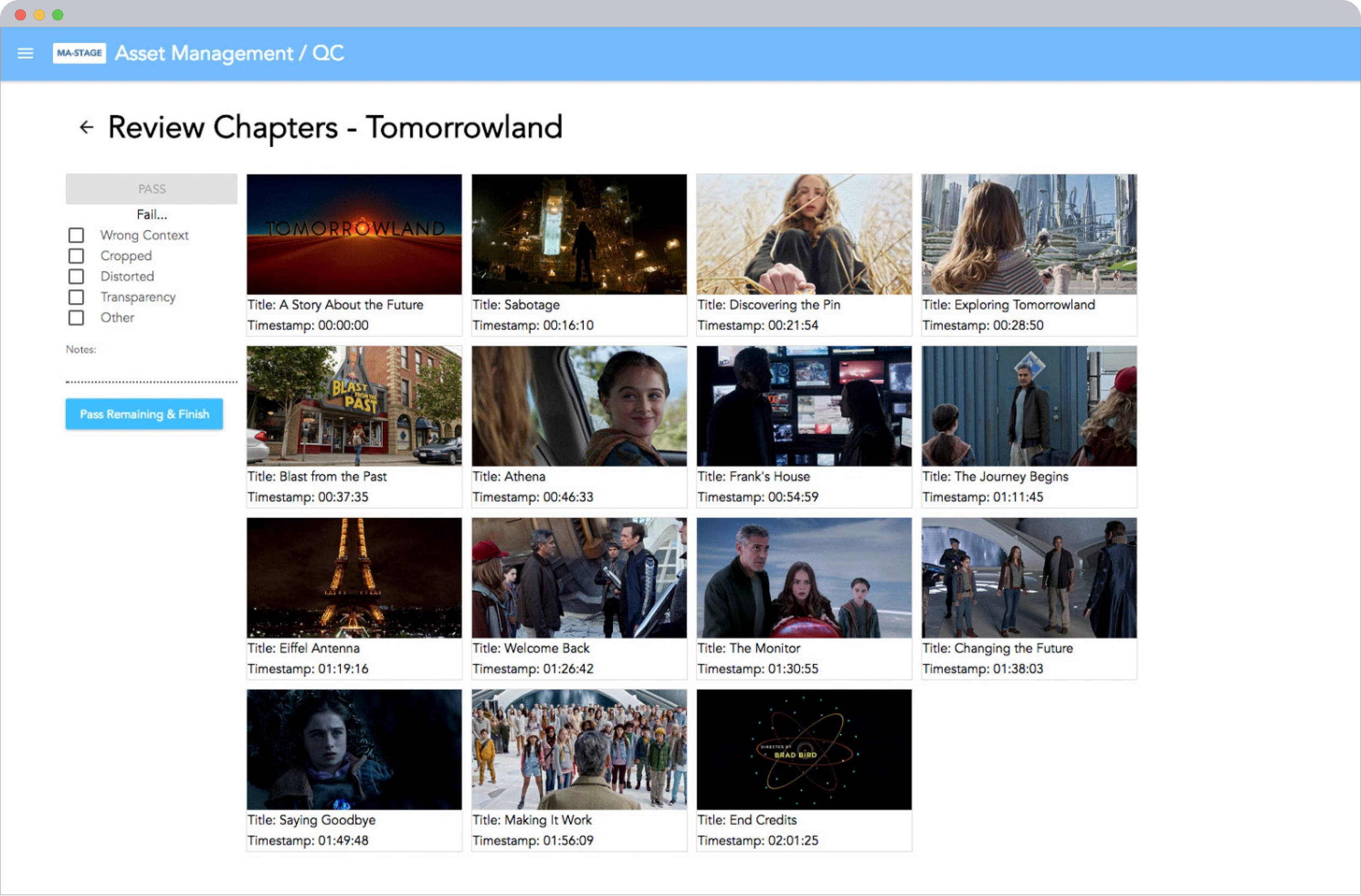Disney’s MoviesAnywhere.com QC Screening Room
Enabling QC review and cataloging of 7,500+ movie titles with custom workflows and interfaces.
Figure 1: Hero image for this case study showing the QC Spot Check Video and Image Review UIs, plus the Report screen used by producers to investigate issues as they are flagged.
Existing Process
To conduct a quality control test on a given movie title, the QC Tester went through a process that entailed the following:
Manually browsing for and pull asset files consisting of HLS/Dash versions of the feature and its trailers, images, chapter information, etc.;
Validate they have the latest versions for each file;
Open and manually scrub through each of the video files;
Open and manually copy/paste/align images into Adobe Photoshop, using pre-defined templates that allowed them to pass/fail images based on size constraints in the interface; and
Documenting their findings at each step in a shared spreadsheet.
High-Level Issues
Task Switching and High Cognitive Load
This existing process was painstakingly-tedious and required switching between multiple browser tabs, windows, and other applications—a task switching nightmare and massive cognitive load that’s required both for managing where in the process a given title is, and also the manual steps within each task to complete it.
3-4 Hours Per Title
On average, a QC Tester would spend an average of three to four hours to review ONE movie title and its accompanying assets, and that’s IF they didn’t encounter any missing or out-of-date files. When they hit a snag with one title, resolving the issue wasn’t instant, so they would start reviewing another movie and come back to it after they got answers.
Data Normalization and Subjectivity Issues
Potential for mistakes and issues with data normalization, plus criteria for passing/failing different types of assets was often subjective.
Accurate and Timely Reporting impossible
Documenting issues, tracking statuses, and cataloging metadata spanned multiple applications, documents, and servers; aggregating these data into accurate reports in a timely manner was practically impossible.
Context
MoviesAnywhere.com is “… a partnership (initially with 20th Century Fox, Sony Pictures, Universal Pictures, and Warner Bros; later more were added) created by Disney Entertainment as a means through which consumers would access and enjoy movies on multiple platforms.” (Wikipedia).
A single movie title is comprised of many component parts: HLS/Dash video files, trailers, images, chapter information, and all of the metadata for each of these. For Disney Movies Anywhere—what already existed and would evolve to become MoviesAnywhere.com—Disney Studios Technology employed a team of Cast Members whose sole job was to manually locate, aggregate, review and document issues for movies already available for subscribers to view online across multiple platforms.
For MoviesAnywhere.com, 7,500+ movie titles needed to go through this QC process. With partner studios added to the mix, the manual workflow and processes were NOT going to scale successfully, nor would they allow for effective communication between studio producers. Leadership decided that backoffice workflows and custom interfaces would need to be created and developed to ensure the teams in place would have tools to achieve this massive undertaking before launch.
That’s where I came in.
Approach
Research and Learning
5-Day Design Sprint Workshop for MVP Concept/Basic Prototype
Prototype Iteration
Usability Testing
Designing and Fleshing Out All Use Cases
Ongoing Reviews & Acceptance with QC, Producers, Engineers, Stakeholders, and Executives
Ongoing Dev Team Support
5-Day Design Sprint Workshop
I decided to conduct a 5-Day Design Sprint workshop to kick off the Design phase after completing the bulk of my research. The book, authored by Jake Knapp, is an incredibly efficient way to go from challenge to prototype in just five days. He provides a 90-second overview of the process in a YouTube video (below).
It’s critical to conduct a workshop like this with participants involved for a full 40-hour week, Monday through Friday. Schedule conflicts would make this impossible unless I scheduled it months in advance—not a viable option. In this case, I ran a lean version of the workshop in a dedicated conference room I booked for the week.
The bulk of each day was spent on my own running through the exercises and activities, and as participants found free time to drop in, I’d walk them through the thinking and milestones thus far so they could provide feedback and make decisions when appropriate.
Research
I needed to learn about existing processes, tasks, documentation methods, friction points, perspectives, business goals, backend technologies being implemented, and much more. To do this, I conducted contextual inquiries and screen-recorded observational working sessions with Quality Control Testers, their managers, Producers, Engineers, Stakeholders, and Executives: 20 people total, with the counts per role as follows:
Quality Control Testers (6)
Quality Control Managers (2)
Producers (4)
Engineers (5)
Stakeholders & Executives (3)
Solution
Leveraging the steps in the 5-day Design Sprint methodology—but without the benefit of having stakeholders and other team contributors fully participating in the 40 hours that’s typical for a sprint of this speed—I explored, sketched, storyboarded and designed a rough-cut prototype to address the aforementioned challenges of this very daunting process.
In the weeks that followed, I collaborated with Patricia Bellantoni (an incredibly-talented UX colleague and mentor of mine at Disney) to:
Refine the over-arching flow;
Detail out steps with greater specificity;
Build an interactive prototype that included necessary nuanced micro-interactions; and
Conduct usability tests with QC Testers who would potentially be future users.
Further, a QC Report made available pass/fail and qualitative notes in real-time after a movie title was tested. This allowed the internal MoviesAnywhere Producers to communicate more effectively with counterparts at partner studios to quickly resolve errors with assets delivered for ingestion.
Significant Increase in Efficiency
Once developed and brought online, this tool allowed a QC tester to pass/fail any given movie title—and all its related assets—in just TEN minutes. That means in the time it used to take to review just ONE title (4 hours), a QC tester can now review 24.
Figure 2. QC Dashboard is an automatic queue from which the user can check-out/-in a movie title that’s ready for testing.
Figure 3. System presents the Trailer and Feature video files (in HLS and Dash formats) sequentially. When reviewing the user can click buttons corresponding to an A/V issue when encountered; doing so automatically records the time and issue type, and a notes field allows for more qualitative details.
CTAs on each step are dynamically labeled based on indicated errors, with some classified as severe enough to warrant an immediate fail and flagging of that title for follow-up by MoviesAnywhere Producers.
Figure 4. Chapters and their corresponding thumbnails are checked for accuracy, context and thumbnail quality.
Figure 5. Key art and title screens are presented in each of the required aspect ratios, with overlays indicating safe zone boundaries (e.g., if a character’s face would be cut-off or partly obscured) and other issues quickly taggable.
QC Report
The net result of reviews being conducted by QC Testers is the QC Report that’s used by MoviesAnywhere Producers to resolve title asset issues that are made available in real-time.
Prototype Walkthrough: QC Report
More to Come…
As of July 15th, 2025, I’m still working on writing more about this case study, but in the meantime, I’m happy to discuss rough drafts and more about the process, challenges, insights, etc. in person.





